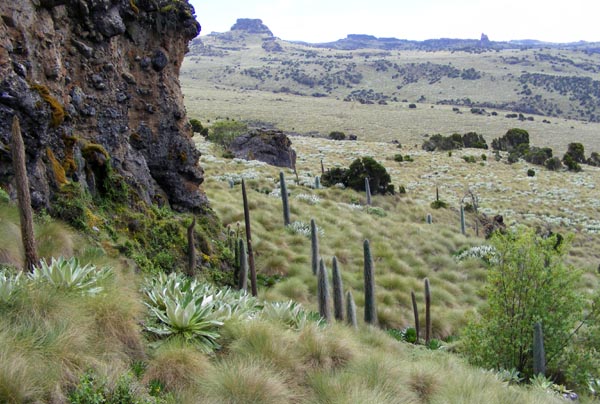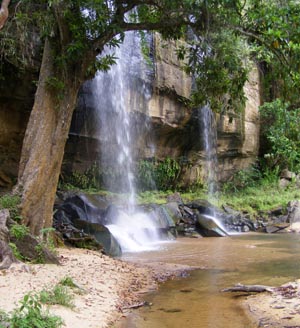In January and February 2010 I visited Kenya with the main goal of collecting fresh pholcid material for DNA sequencing. Kenya has the big advantage of being home to representatives of several pholcid species groups that otherwise have their main distributions in Ethiopia, the Congo Basin, and the Eastern Arc respectively. However, to get all these species we had to drive over 3500 km, first to Taita Hills and the coastal forests in the south (Arabuko, Shimba Hills), then north to Ol Donyo, Mt. Kenya and Mt. Elgon, and finally to Kakamega and Mau Escarpment.

One special
question I had in mind was up to which altitude pholcid spiders might
be found. The highest record at that time was from the Chilean Andes,
where Chibchea araona has
been found at
3620 m (Huber 2000). In
Africa, the highest record was at 3500 m (for Buitinga kanzuiri on Ruwenzori
Mountain; see Huber 2003), so we
went up Mt. Kenya and Mt. Elgon until no more pholcids could be found.
In a small cave at the Naro Moru side of Mt. Kenya we found 'Spermophora' minotaura at 3580 m,
close to the site shown below. In the meantime, the highest African
record is from the Ruwenzori Mountains and the highest record worldwide
is from the Andes again (see here).

 In
general, species diversity was rather low, with a maximum of four
species per locality. In extreme cases we found only one single species
in forests that looked fairly good, like those near Sheldrick Falls in
Shimba Hills (left). In comparison, 12 and more species can be found at
many localities in the Brazilian
Atlantic Forest.
In
general, species diversity was rather low, with a maximum of four
species per locality. In extreme cases we found only one single species
in forests that looked fairly good, like those near Sheldrick Falls in
Shimba Hills (left). In comparison, 12 and more species can be found at
many localities in the Brazilian
Atlantic Forest. About 10-12 new species were discovered during this trip, but the highlight was the first representative of the genus Quamtana for East Africa. Quamtana is widely distributed in South Africa but was otherwise known only from a few high altitude areas in Cameroon and the Ruwenzori Mountains (Huber 2003). We found it at one locality only, in the forests below Thompson Falls near Nyahururu. In the meantime, we described this species as Quamtana nyahururu.
The material collected during this trip has been crucial for several publications: a revision of Pholcus (Huber 2011), a revision of Smeringopus (Huber 2012), an overview of East African pholcids (Huber & Warui 2012), and the most recent molecular phylogeny of the family (Dimitrov et al. 2012).
I owe thanks to Charles Warui for help with permits and preparations, and especially to Reuben Mwakodi who was an excellent driver, guide, and field assistant. I thank the German Research Foundation for financing this expedition (DFG Project HU 980/9-1).
